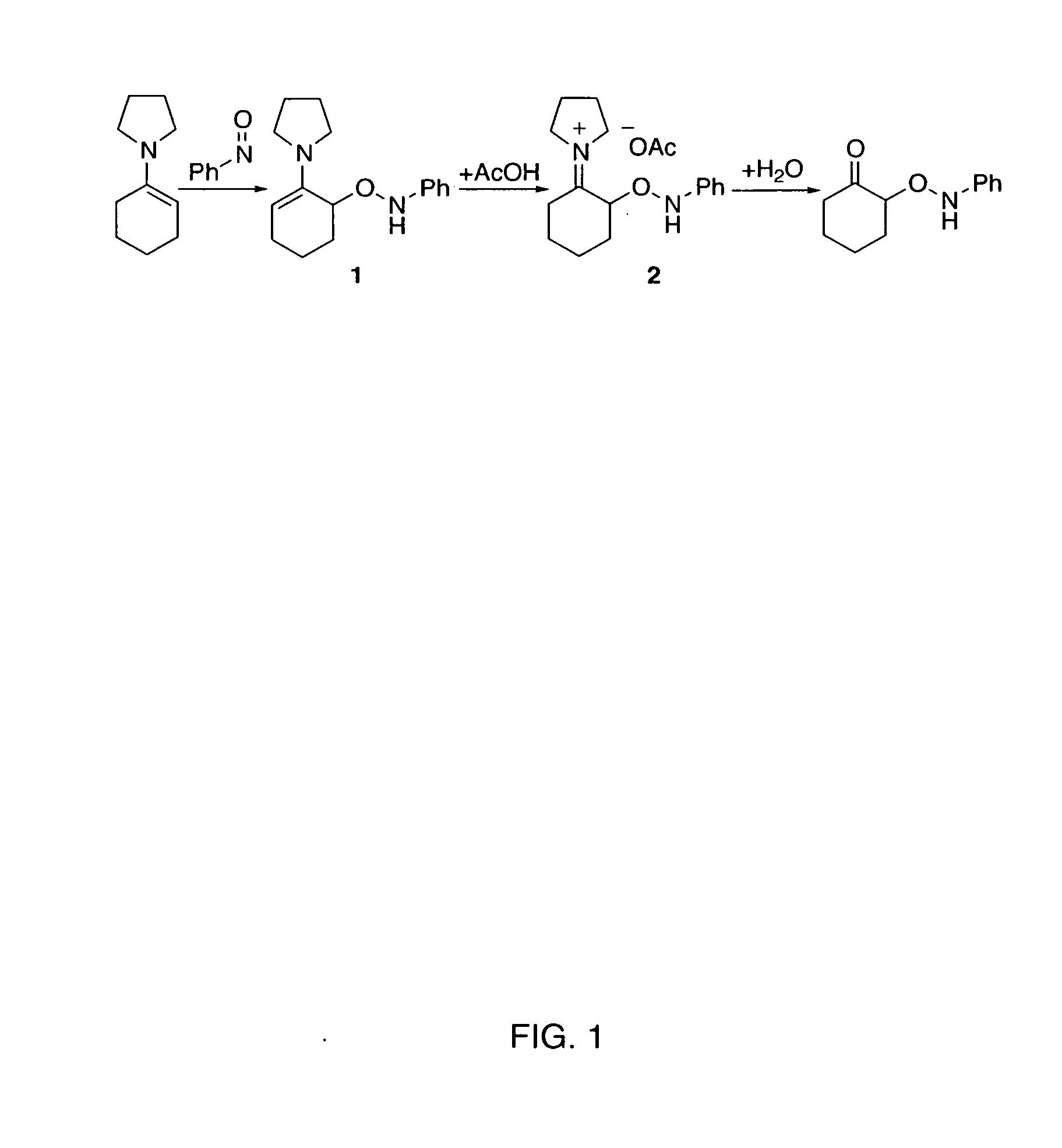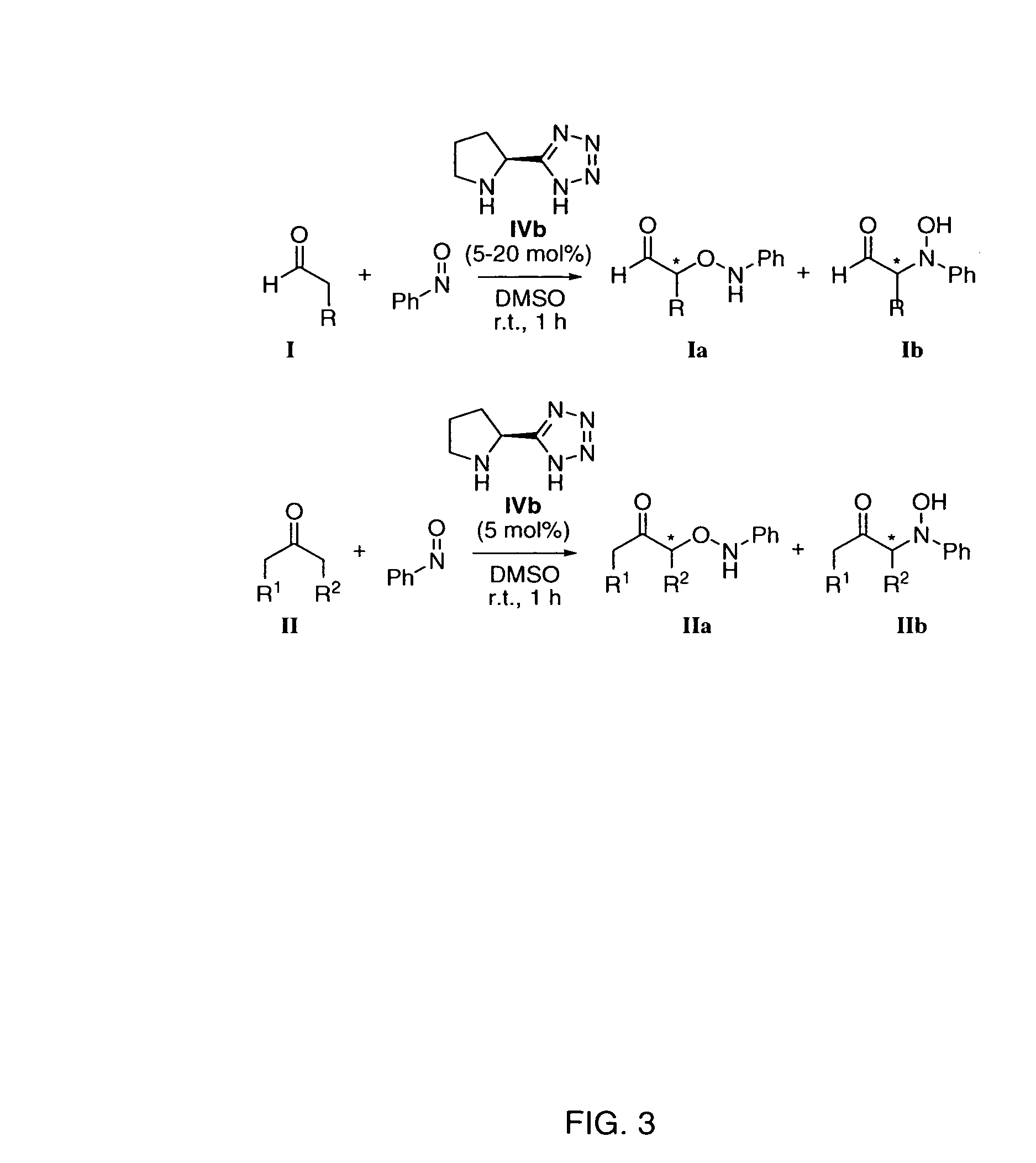Process of making alpha-aminooxyketone/alpha-aminooxyaldehyde and alpha-hydroxyketone/alpha-hydroxyaldehyde compounds and a process making reaction products from cyclic alpha,beta-unsaturated ketone substrates and nitroso substrates
a technology of alpha-aminooxyaldehyde and alpha-hydroxyketone, which is applied in the preparation of amino-carboxyl compounds, chemistry apparatus and processes, and can solve the problems of low atom efficiency, lack of catalytic efficiency, and inability to consistently reproduce, and achieve high purity and enantioselectivity
- Summary
- Abstract
- Description
- Claims
- Application Information
AI Technical Summary
Problems solved by technology
Method used
Image
Examples
example 1
General Procedure for the Enantioselective O-Nitroso Aldol Reaction Between a Ketone and Nitrosobenzene in the Presence of (L)-Pyrrolidine-Based Tetrazole Catalyst of Formula IVb
[0238] To a room temperature solution of pyrrolidine-based tetrazole catalyst (5 mol %) and ketone (1.5 mmol, 3 eq) in DMSO (1 ml) was added the solution of nitrosobenzene (0.5 mmol, 1 eq) in DMSO (1 mL) dropwise for 1 h. The resulting mixture was stirred at this temperature until the nitrosobenzene was completely consumed (1 h), as determined by TLC (hexane / ethyl acetate=3 / 1). The reaction mixture was then poured into an iced saturated NH4Cl solution. The aqueous layer was extracted with ethyl acetate (20 mL×3). The combined organic extracts were washed with brine, dried over Na2SO4 with cooling and concentrated under reduced pressure after filtration. The residual crude product was chromatographed on a two-layered column filled with Florisil® (upper layer) and silica gel (lower layer) using a mixture of e...
example 2
General Procedure for the Enantioselective O-nitroso Aldol Reaction Between an Aldehyde and Nitrosobenzene in the Presence of (L)-pyrrolidine-Based Tetrazole Catalyst of Formula IVb
[0239] To a room temperature solution of pyrrolidine-based tetrazole catalyst (10 mol %) in acetonitrile (1 mL) was added nitrosobenzene (1 equiv, 0.5 mmol) in one portion and stirred at room temperature for 10 min. To this green heterogeneous solution was then added aldehyde (3 equiv, 1.5 mmol) in one portion. The resulting mixture was stirred at this temperature until the nitrosobenzene was completely consumed (15-30 min), as determined by TLC (hexane / ethyl acetate=2 / 1). Then, the reaction was transferred to a methanol suspension of NaBH4 at 0° C. After 20 min, the reaction mixture was then poured into saturated NH4Cl solution. The aqueous layer was extracted with diethyl ether (20 mL×3). The combined organic extracts were dried over Na2SO4 with cooling and concentrated under reduced pressure after fil...
example 3
Procedure for the Synthesis of α-hydroxy Cyclohexanone
[0240] To a room temperature solution of pyrrolidine-based tetrazole catalyst (5 mol %) and cyclohexanone (3 equiv, 1.5 mmol) in DMSO (1 mL) was added the solution of nitrosobenzene (1 equiv, 0.5 mmol) in DMSO (1 mL) dropwise for 1 h. The resulting mixture was stirred at this temperature until the nitrosobenzene was completely consumed (1 h), as determined by TLC (hexane / ethyl acetate=3 / 1). After cooling to 0° C., CuSO4 (0.3 eq) and MeOH (3 mL) were added and stirred at 0° C. for 10 h. The reaction mixture was quenched by cooled brine (20 mL) and the aqueous layer was extracted with ethyl acetate (10 mL×3). The combined organic extracts were washed with brine, dried over Na2SO4 with cooling and concentrated under reduced pressure after filtration. The residual crude product was chromatographed on a silica gel using a mixture of ethyl acetate and hexane as the eluant to give the product.
PUM
| Property | Measurement | Unit |
|---|---|---|
| temperature | aaaaa | aaaaa |
| temperature | aaaaa | aaaaa |
| temperature | aaaaa | aaaaa |
Abstract
Description
Claims
Application Information
 Login to View More
Login to View More - R&D
- Intellectual Property
- Life Sciences
- Materials
- Tech Scout
- Unparalleled Data Quality
- Higher Quality Content
- 60% Fewer Hallucinations
Browse by: Latest US Patents, China's latest patents, Technical Efficacy Thesaurus, Application Domain, Technology Topic, Popular Technical Reports.
© 2025 PatSnap. All rights reserved.Legal|Privacy policy|Modern Slavery Act Transparency Statement|Sitemap|About US| Contact US: help@patsnap.com



